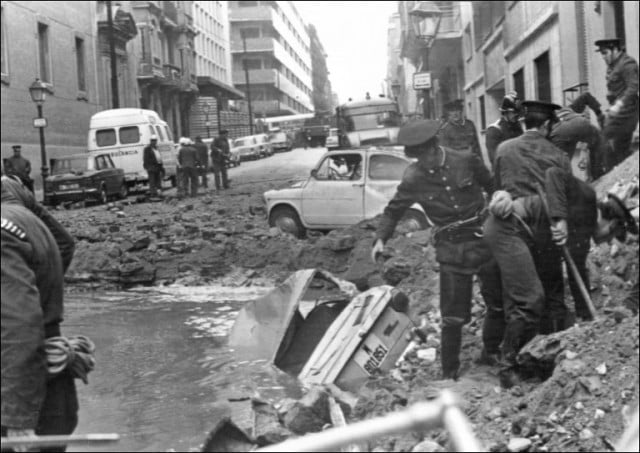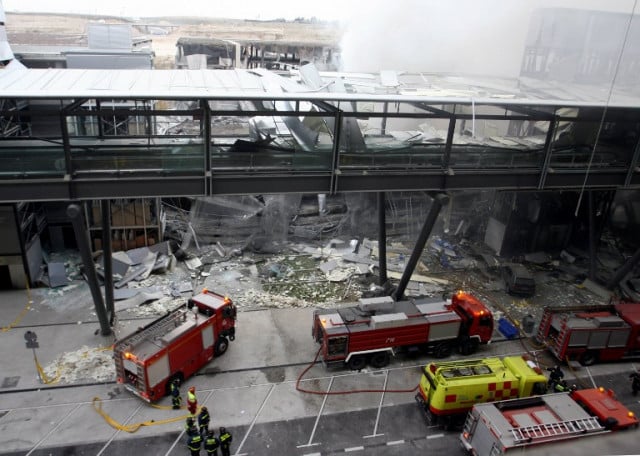ETA's bloody history: 829 deaths in a six-decade struggle

Key dates in the history of the armed Basque separatist movement ETA, which has announced its dissolution.
Fight against dictatorship
July 31, 1959: ETA (Euskadi Ta Askatasuna) is formed during the dictatorship of General Francisco Franco by a group of Basque nationalist students.
June 7, 1968: ETA shoots dead the police chief of the Basque city of San Sebastian -- the first deadly attack for which it claimed responsibility.
December 20, 1973: Luis Carrero Blanco, Franco's prime minister and presumed successor, is blown up in his car in Madrid -- one of ETA's most notorious attacks.

Policemen search among the damages caused by a bomb attack, 20 December 1973, in which Prime Minister Luis Carrero Blanco has been killed. Archive photo: AFP
Democracy targeted
October 15, 1977: Two years after Franco's death, a general amnesty for political prisoners, including from ETA, is declared by the first democratic
government.
October 25, 1979: The Basque region is granted autonomy status.
1980: ETA's most deadly year, with at least 92 people killed in attacks.
December 1983: Emergence of GAL, a paramilitary group which kills 28 Basque militants through 1987.
June 19, 1987: ETA stages its deadliest bombing, killing 21 shoppers at a Barcelona supermarket car park.
July 12, 1997: ETA shoots a conservative town councillor in the Basque country who dies of his wounds the next day. Millions take to the streets in protest.
Broken ceasefires
September 16, 1998: ETA announces a unilateral and unlimited ceasefire, which it goes back on in late 1999 after the failure of talks with the government.
March 17, 2003: Batasuna, ETA's political wing created in 1978, is outlawed.
March 22, 2006: ETA declares a "permanent ceasefire" in return for talks with the government.
December 30, 2006: ETA claims responsibility for a bombing at Madrid airport that kills two people, breaking the ceasefire. ETA goes on to carry out seven attacks by the summer 2009.

Wreckage after the bomb exploded at Madrid's Barajas airport. Photo: AFP
November 17, 2008: ETA's military chief Garikoitz Aspiazu Rubina is arrested in France. His five successors are in turn arrested. -
August 9, 2009: ETA carries out its last attacks on Spanish soil.
In March 2010 its last victim is a French policeman killed during a chase in the Paris region.
End of armed struggle
October 20, 2011: ETA announces "the definitive end to its armed activity", but declines to formally disband or disarm. A month later the leftist separatist coalition Amaiur, an offshoot of Batasuna, enters the
Spanish parliament.
November 24, 2012: ETA says it may discuss disbanding if jailed members are moved to prisons nearer home. Spain refuses to negotiate.
April 8, 2017: ETA announces its "total disarmament". It provides France with a list of locations for its arms caches, a move hailed by France but said to be insufficient by Madrid. Several weeks later ETA says it has started an internal discussion on its future.
Towards dissolution
February 22, 2018: ETA starts to vote on its dissolution, the Basque daily Gara reports.
April 20, 2018 - ETA apologises for the "pain" and "harm" it caused during its armed campaign and appeals to some of its victims - those "not involved in the conflict" - for forgiveness.
May 2, 2018: ETA publishes a letter announcing that it was fully disbanding, the final step to the definitive end of its deadly decades-long independence campaign.
READ ALSO: The end of Basque struggle: ETA announces dissolution.
Comments
See Also
Fight against dictatorship
July 31, 1959: ETA (Euskadi Ta Askatasuna) is formed during the dictatorship of General Francisco Franco by a group of Basque nationalist students.
June 7, 1968: ETA shoots dead the police chief of the Basque city of San Sebastian -- the first deadly attack for which it claimed responsibility.
December 20, 1973: Luis Carrero Blanco, Franco's prime minister and presumed successor, is blown up in his car in Madrid -- one of ETA's most notorious attacks.

Policemen search among the damages caused by a bomb attack, 20 December 1973, in which Prime Minister Luis Carrero Blanco has been killed. Archive photo: AFP
Democracy targeted
October 15, 1977: Two years after Franco's death, a general amnesty for political prisoners, including from ETA, is declared by the first democratic
government.
October 25, 1979: The Basque region is granted autonomy status.
1980: ETA's most deadly year, with at least 92 people killed in attacks.
December 1983: Emergence of GAL, a paramilitary group which kills 28 Basque militants through 1987.
June 19, 1987: ETA stages its deadliest bombing, killing 21 shoppers at a Barcelona supermarket car park.
July 12, 1997: ETA shoots a conservative town councillor in the Basque country who dies of his wounds the next day. Millions take to the streets in protest.
Broken ceasefires
September 16, 1998: ETA announces a unilateral and unlimited ceasefire, which it goes back on in late 1999 after the failure of talks with the government.
March 17, 2003: Batasuna, ETA's political wing created in 1978, is outlawed.
March 22, 2006: ETA declares a "permanent ceasefire" in return for talks with the government.
December 30, 2006: ETA claims responsibility for a bombing at Madrid airport that kills two people, breaking the ceasefire. ETA goes on to carry out seven attacks by the summer 2009.

Wreckage after the bomb exploded at Madrid's Barajas airport. Photo: AFP
November 17, 2008: ETA's military chief Garikoitz Aspiazu Rubina is arrested in France. His five successors are in turn arrested. -
August 9, 2009: ETA carries out its last attacks on Spanish soil.
In March 2010 its last victim is a French policeman killed during a chase in the Paris region.
End of armed struggle
October 20, 2011: ETA announces "the definitive end to its armed activity", but declines to formally disband or disarm. A month later the leftist separatist coalition Amaiur, an offshoot of Batasuna, enters the
Spanish parliament.
November 24, 2012: ETA says it may discuss disbanding if jailed members are moved to prisons nearer home. Spain refuses to negotiate.
April 8, 2017: ETA announces its "total disarmament". It provides France with a list of locations for its arms caches, a move hailed by France but said to be insufficient by Madrid. Several weeks later ETA says it has started an internal discussion on its future.
Towards dissolution
February 22, 2018: ETA starts to vote on its dissolution, the Basque daily Gara reports.
April 20, 2018 - ETA apologises for the "pain" and "harm" it caused during its armed campaign and appeals to some of its victims - those "not involved in the conflict" - for forgiveness.
May 2, 2018: ETA publishes a letter announcing that it was fully disbanding, the final step to the definitive end of its deadly decades-long independence campaign.
READ ALSO: The end of Basque struggle: ETA announces dissolution.
Join the conversation in our comments section below. Share your own views and experience and if you have a question or suggestion for our journalists then email us at [email protected].
Please keep comments civil, constructive and on topic – and make sure to read our terms of use before getting involved.
Please log in here to leave a comment.